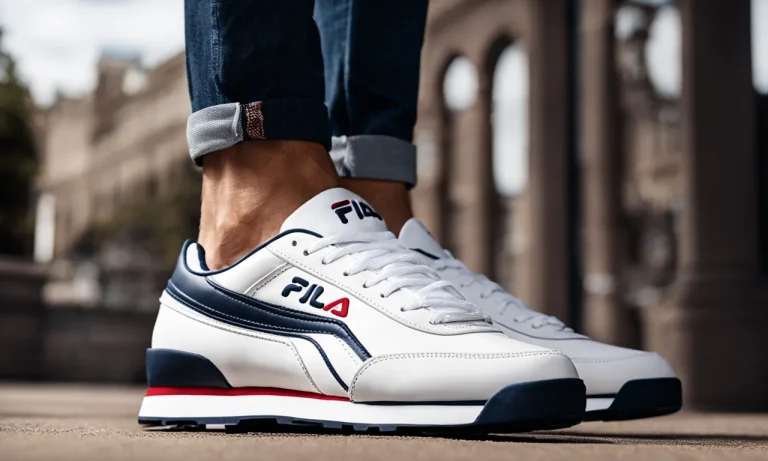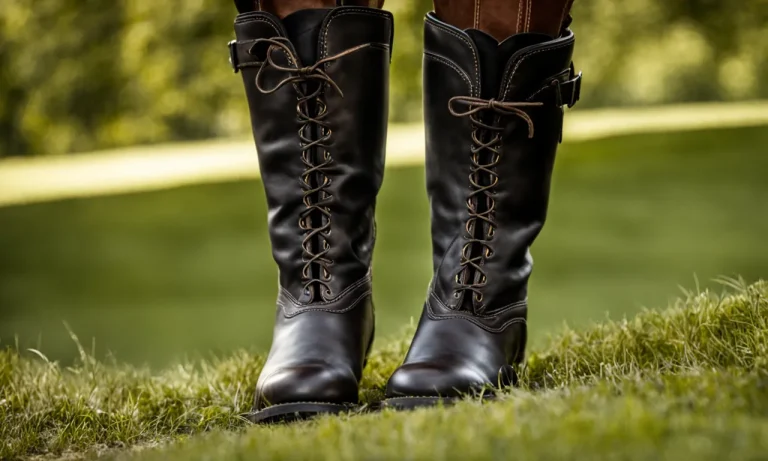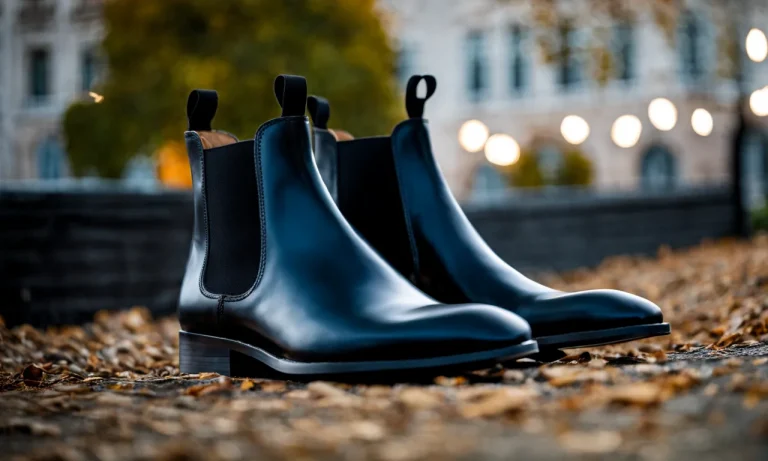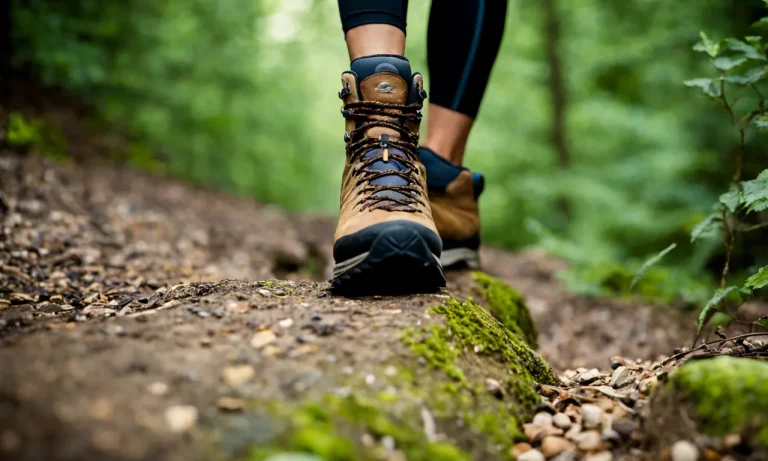Shoes may seem simple, but they are engineered with many parts that work together to support and protect your feet. If you’ve ever wondered what’s inside your sneakers, boots, heels, or sandals, read on for an in-depth tour of shoe anatomy.
If you’re short on time, here’s a quick answer to your question: Shoes contain the upper, lining, insole, midsole, outsole, shank, and hardware like eyelets and hooks that all work together to provide comfort, support, flexibility and durability for your feet.
In this comprehensive guide, we’ll examine the form and function of the key components of shoe construction. You’ll learn the importance of the upper, what materials make up shoe linings, the types of insoles and midsoles used, and how the outsole impacts traction and durability.
We’ll also explore the internal reinforcements and exterior hardware parts that hold your shoes together and adjust the fit.
The Upper
When it comes to shoes, the upper part plays a crucial role in providing comfort, support, and style. The upper refers to the part of the shoe that covers the foot from the toes to the ankle. It is responsible for protecting the foot and ensuring a secure fit.
Materials Used for Uppers
Shoe uppers can be made from a variety of materials, each with its own unique properties. One commonly used material is leather, which is known for its durability and flexibility. Leather uppers provide a classic and sophisticated look to shoes, making them a popular choice for dress shoes and boots.
Another popular material for shoe uppers is synthetic fabrics, such as nylon and polyester. These materials are lightweight, breathable, and often more affordable compared to leather. They are commonly used in athletic shoes and sneakers, as they allow for greater movement and ventilation.
Furthermore, there are also uppers made from mesh or knit materials. These materials offer excellent breathability and flexibility, making them ideal for running shoes and casual sneakers. They provide a snug fit while allowing the foot to move naturally.
Parts of the Upper
The upper of a shoe consists of several parts that contribute to its overall structure and functionality. One important component is the vamp, which covers the front part of the foot and includes the toe box. The vamp helps protect the toes and provides support.
The quarters are the parts of the upper that wrap around the sides and back of the foot. They help secure the foot and provide stability. The heel counter, located at the back of the shoe, reinforces the heel and prevents it from slipping out of the shoe.
In addition, many shoes have a tongue, which is a separate piece of material that lies under the laces. The tongue helps cushion the top of the foot and prevents the laces from digging into the skin. It also keeps debris from entering the shoe.
Lastly, some shoes have additional features like overlays or straps that provide extra support and structure to the upper. These components are strategically placed to enhance the fit and overall performance of the shoe.
Understanding the anatomy of a shoe’s upper can help you make informed decisions when choosing the right pair for your needs. Consider the materials used and the specific parts that contribute to the comfort, support, and style you desire.
With the right upper, your shoes will not only look great but also provide the necessary functionality for your feet.
The Lining
When it comes to the anatomy of a shoe, the lining is an essential component that is often overlooked. The lining refers to the material that is used on the inside of the shoe, providing comfort and protection for the wearer’s foot.
It plays a crucial role in ensuring a comfortable fit and preventing friction or irritation.
The lining of a shoe can be made from various materials, depending on the type and purpose of the shoe. Common materials used for lining include leather, fabric, and synthetic materials. Leather linings are known for their durability and breathability, making them a popular choice for high-quality shoes.
Fabric linings, on the other hand, offer a softer and more cushioned feel.
The lining also serves to protect the foot from coming into direct contact with the shoe’s upper materials, which may be rough or abrasive. It acts as a barrier between the foot and the exterior of the shoe, preventing discomfort and potential blisters.
In addition to providing comfort and protection, the lining of a shoe can also have moisture-wicking properties. This means that it is designed to absorb and dissipate moisture, keeping the foot dry and comfortable throughout the day.
This is especially important for athletic shoes or shoes that are worn for long periods.
It’s worth noting that the quality of the lining can greatly impact the overall comfort and longevity of a shoe. A well-made shoe with a high-quality lining will not only feel great on the foot but will also last longer and withstand regular wear and tear.
When purchasing a new pair of shoes, it’s always a good idea to pay attention to the lining and ensure that it is well-made and comfortable. A good lining can make all the difference in how a shoe feels and performs.
So, the next time you slip on a pair of shoes, take a moment to appreciate the often underrated but essential component – the lining.
The Insole
The insole is an essential part of a shoe that provides comfort and support to the wearer’s feet. It is the inner layer of the shoe that comes in direct contact with the foot. The design and materials used in the insole play a crucial role in determining the overall comfort and performance of the shoe.
Cushioned Insoles
Cushioned insoles are designed to provide extra padding and shock absorption to the feet. They are made using materials like foam, gel, or air pockets that help to distribute the pressure evenly and reduce the impact on the feet.
These insoles are particularly beneficial for individuals who spend long hours on their feet or engage in high-impact activities such as running or jumping.
One popular type of cushioned insole is the memory foam insole. This type of insole molds to the shape of the foot, providing personalized comfort and support. It offers excellent cushioning and helps to relieve pressure points, making it ideal for individuals with foot conditions like plantar fasciitis or arthritis.
Supportive Insoles
Supportive insoles, also known as orthotic insoles, are designed to provide stability and correct foot alignment. They are often recommended for individuals with flat feet, high arches, or other foot-related issues.
Supportive insoles are made using materials like firm foam or plastic, which help to control excessive pronation or supination of the foot.
These insoles typically have a contoured shape that supports the arch of the foot and provides additional cushioning to the heel and forefoot. They help to distribute body weight evenly, alleviate foot pain, and prevent injuries caused by poor foot alignment.
Supportive insoles can be custom-made to fit the individual’s foot or purchased as over-the-counter inserts.
It’s important to note that the choice between cushioned insoles and supportive insoles depends on the individual’s foot type, activity level, and specific needs. Some individuals may benefit from a combination of both types of insoles, while others may find one type more suitable for their feet.
For more information on shoe anatomy and foot health, you can visit www.foothealthfacts.org, a website maintained by the American College of Foot and Ankle Surgeons.
The Midsole
The midsole is a crucial component of a shoe that provides cushioning, support, and stability. It is located between the outsole, which makes contact with the ground, and the upper, which holds the foot in place.
The midsole material plays a significant role in determining the overall comfort and performance of a shoe.
EVA Midsoles
EVA (ethylene-vinyl acetate) is a popular material used in midsoles due to its excellent cushioning properties. It is lightweight, flexible, and absorbs impact forces effectively, reducing stress on the feet and joints.
EVA midsoles are commonly found in running shoes and athletic footwear, providing a comfortable and responsive ride. They are also known for their durability, retaining their cushioning properties even after prolonged use.
Polyurethane Midsoles
Polyurethane (PU) midsoles are another common type of midsole material. They offer excellent durability and stability, making them suitable for shoes that require extra support. PU midsoles provide a firmer feel compared to EVA, making them ideal for activities that involve heavy impact forces or long hours of standing.
They are often found in work boots, hiking shoes, and other footwear designed for rugged use.
Rubber Midsoles
Rubber midsoles are known for their excellent traction and durability. They are commonly used in athletic shoes, especially those designed for outdoor sports like basketball and tennis. Rubber midsoles provide a responsive feel and help enhance grip on various surfaces.
They also offer good shock absorption, making them suitable for high-impact activities.
It’s important to note that some shoes may combine different midsole materials to maximize their performance and comfort. For example, a running shoe might feature an EVA midsole for cushioning and a rubber outsole for traction.
Understanding the different types of midsoles can help you choose the right shoe for your specific needs.
The Outsole
When it comes to the anatomy of a shoe, one of the most important components is the outsole. The outsole is the part of the shoe that comes into direct contact with the ground, providing traction and stability. It plays a crucial role in determining the overall performance and durability of the shoe.
Outsole Tread Patterns
The tread pattern on the outsole is designed to provide grip on various surfaces. Different types of tread patterns are used for different purposes. For example, a shoe designed for running on trails might have a more aggressive tread pattern with deep lugs to provide traction on uneven terrain.
On the other hand, a shoe designed for running on roads might have a flatter and smoother tread pattern for better grip on pavement.
Common types of tread patterns include:
- Hexagonal: Hexagonal-shaped lugs provide multi-directional grip and are commonly found on running shoes.
- Waffle: Waffle-shaped lugs provide excellent traction and are often seen on shoes designed for cross-training or outdoor activities.
- Herringbone: Herringbone-shaped lugs are commonly found on basketball shoes and provide great grip for quick lateral movements.
- Circular: Circular lugs offer 360-degree traction and are commonly used on shoes designed for indoor sports like volleyball or basketball.
The choice of tread pattern depends on the intended use of the shoe. Whether it’s for running, hiking, or playing sports, selecting the right tread pattern can greatly enhance performance and minimize the risk of slipping or sliding.
Outsole Materials
The outsole is typically made from a variety of materials, each with its own characteristics and benefits. The most common materials used for outsoles include rubber, carbon rubber, and synthetic compounds.
Rubber outsoles are known for their excellent traction, durability, and flexibility. They provide a good grip on both wet and dry surfaces, making them ideal for outdoor activities. Carbon rubber outsoles, on the other hand, offer even greater durability and are often used in high-performance shoes that need to withstand intense wear and tear.
Synthetic compounds, such as ethylene-vinyl acetate (EVA) or thermoplastic polyurethane (TPU), are often used in athletic shoes to provide cushioning and shock absorption. These materials are lightweight and offer good traction, making them suitable for running and other sports where comfort is a priority.
It’s worth noting that some shoe manufacturers also incorporate specialized technologies and materials into their outsoles to enhance performance. One example is Nike’s Air Zoom technology, which uses air-filled chambers in the outsole to provide responsive cushioning and energy return.
Understanding the different types of outsole tread patterns and materials can help you make an informed decision when choosing the right shoe for your specific needs. Whether you’re a professional athlete or a casual runner, having the right outsole can make a significant difference in your overall experience and performance.
Internal Reinforcements
Shank
The shank is an essential component of the shoe’s internal structure that provides stability and support. It is a piece of material, often made of metal or fiberglass, that runs along the bottom of the shoe, from the heel to the arch.
The shank helps to distribute the weight of the body evenly across the foot, preventing the shoe from collapsing under pressure.
The use of a shank in shoe construction can vary depending on the type of shoe. For example, athletic shoes may have a more flexible shank to allow for natural foot movement during physical activities, while dress shoes may have a stiffer shank for added support and structure.
For more information on shoe shanks, you can visit Orthotics Direct.
Toe Box
The toe box is the front part of the shoe that surrounds and protects the toes. It is typically made of a reinforced material, such as leather or synthetic fabrics, to provide durability and prevent injuries.
The size and shape of the toe box can vary depending on the shoe’s style and purpose. For example, running shoes often have a wider toe box to allow for natural toe movement and accommodate the foot’s swelling during physical activity.
On the other hand, dress shoes may have a narrower toe box for a more elegant look.
It is important to choose a shoe with a properly fitting toe box to avoid discomfort, blisters, and other foot problems. For more information on selecting the right shoe size, you can visit American Podiatric Medical Association.
Heel Counter
The heel counter is a stiff piece of material that wraps around the back of the shoe’s heel. It provides stability and support to the heel, preventing excessive movement and reducing the risk of injuries such as sprains or strains.
The materials used for the heel counter can vary, ranging from plastic to reinforced fabric. The stiffness of the heel counter depends on the shoe’s intended use. For example, athletic shoes may have a more rigid heel counter to provide better support during high-impact activities, while casual shoes may have a softer heel counter for increased comfort.
When trying on shoes, it is important to pay attention to the fit and support provided by the heel counter. A well-fitted shoe with a supportive heel counter can help maintain proper foot alignment and reduce the risk of foot and ankle problems.
For more information on heel counter support, you can visit Foot Health Facts.
Hardware
Eyelets
Eyelets are small metal rings that are inserted into the shoe’s upper material to create openings for shoelaces to pass through. They are typically made of materials such as brass or stainless steel, which are durable and resistant to corrosion.
Eyelets not only provide structural integrity to the shoe but also allow for easy adjustment and tightening of the laces. They are strategically placed along the sides of the shoe to ensure a secure and comfortable fit.
Hooks
Hooks are another type of hardware commonly found on certain types of shoes, such as hiking boots or work boots. They are typically made of metal and provide a quick and easy way to tighten or loosen the laces.
Hooks are designed to securely hold the laces in place, preventing them from slipping or coming undone during activity. This feature is especially useful in outdoor or rugged environments where a secure fit is essential.
Buckles
Buckles are a type of fastening hardware commonly used in dress shoes or certain types of boots. They are typically made of metal and consist of a frame with a movable tongue or pin. Buckles offer a stylish and secure alternative to traditional laces or Velcro closures.
They allow for easy adjustability, ensuring a snug fit while adding a touch of elegance to the shoe’s overall design.
Shoelaces
Shoelaces are the strings or cords used to fasten and secure the shoe around the foot. They are typically made of materials such as cotton, polyester, or nylon and come in various lengths and thicknesses.
Shoelaces are threaded through the eyelets or hooks of the shoe, allowing the wearer to tighten or loosen them as needed. They play a crucial role in providing a comfortable and secure fit, preventing the shoe from slipping off during movement.
For more information on the anatomy of a shoe and its hardware components, you can visit websites such as Sneaker Freaker or Business of Fashion.
Conclusion
From the upper materials to the outsole tread, every part of a shoe is engineered for durability, support, and comfort. Now that you know the anatomy of a shoe’s construction, you can make more informed choices when shopping for your next pair.
Understanding the components that make up your shoes allows you to select footwear that has the features you need. Whether you prefer the cushioning of a well-padded insole, flexibility from a soft midsole, or traction from a rugged outsole, you can find shoes tailored for your needs by looking inside.






